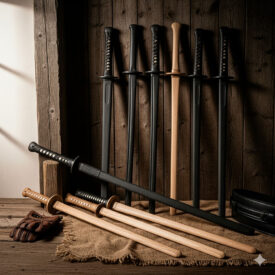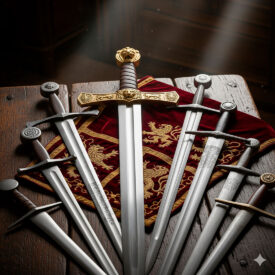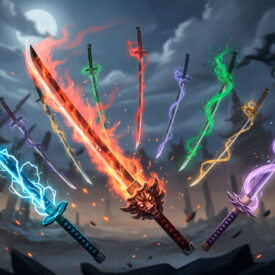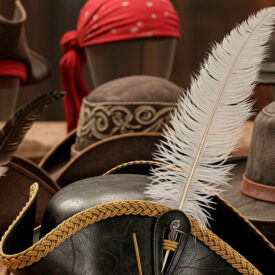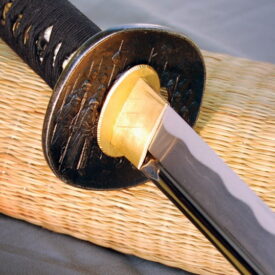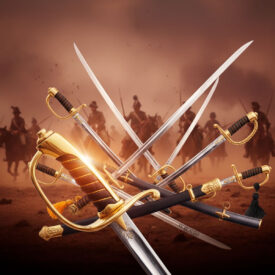What did a sailor see when drawing his sword on the slippery deck amidst rain and gunpowder? The image of the cutlass gleaming in the sun, the curve of the blade ready for a decisive cut, still resonates in stories, movies, and in the minds of those seeking to revive the era of naval assaults. This article guides you through the history, typology, technique, and selection of pirate sword replicas, combining historical data, evocative narrative, and practical advice for enthusiasts and re-enactors.
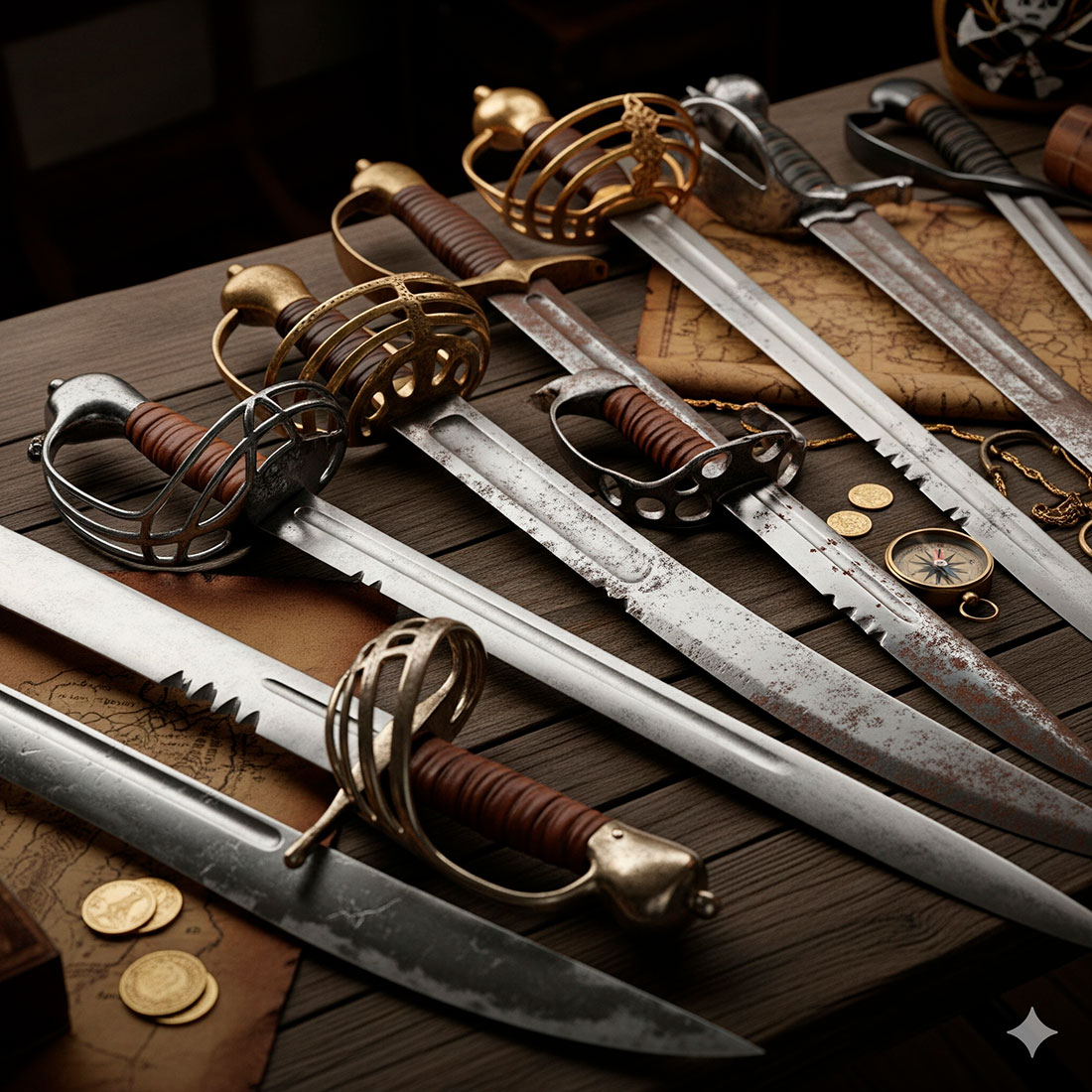
Legend becomes blade: a brief historical overview
Sea marauders have an ancient lineage: the Greeks already called those who attacked ships and took loot pirates four hundred years before Christ. Over the centuries, these attacks evolved in tactics, legalities, and tools. Among the terms that emerged were privateers, licensed by patent to operate with state permission, and buccaneers who occupied coasts and coves as operational bases.
At their peak, during the 17th and 18th centuries — the so-called Golden Age of Piracy — the Caribbean and the Atlantic were the scene of assaults, ephemeral alliances, and armaments created for the chaos of the deck: flintlock pistols, axes, knives and, above all, short, curved swords that allowed attacking and moving in confined spaces.
Cutlass and naval bladed weapons: evolution and use throughout time
The cutlass was the short sword most associated with pirate activity and life on deck: a wide, curved, single-edged blade, a protective handguard, and great maneuverability in confined spaces. Below is an ordered chronology of its use and the naval armament context according to the provided sources.
| Era | Event |
|---|---|
| Middle Ages — Renaissance | |
| Middle Ages to the Renaissance | The term and type of sword known as alfanje (of Arabic origin) is used in the Iberian Peninsula and the Mediterranean. Weapons from the East (China and Mongolia) are adapted and modified in medieval Europe. |
| Age of Piracy and Sailing (15th–18th centuries) | |
| 15th, 16th, 17th, and 18th Centuries | Pirates, privateers, buccaneers, and filibusters use short swords or cutlasses in boarding actions: more practical than long sabers in the limited space of a ship. |
| Mid-16th Century | The musket begins to be used frequently; firearms coexist with bladed weapons despite their low accuracy and slow reload. |
| Around 1600 | Pistols become more useful for naval combatants with the arrival of the flintlock mechanism. In parallel, fine dueling swords appear among the nobility. |
| Mid-17th Century — Early 18th Century | Period known as the Golden Age of Piracy. Pirates use a variety of weapons (including cutlasses) to plunder ships; the cutlass consolidates as the preferred weapon for its speed and effectiveness in close-quarters combat on narrow decks. |
| 1690s | The replacement of the matchlock mechanism by the flintlock mechanism in firearms occurs, which improves the utility of pistols. |
| Mid-18th Century | Documentation and illustrations (e.g., the Naval Construction Album of the Marquis of La Victoria) show the use and design of sabers and cutlasses in naval contexts. |
| 1760–1890 | Documented period of use of swords and sabers by the Royal Navy’s sailors; bladed weapons remain part of naval equipment. |
| Late 19th Century | The cutlass is adopted by naval officers as an identifying weapon and symbol; its effectiveness in naval wars led to its recognition as a representative weapon, although not always as a regulation weapon in Europe until the end of the century. Example: the naval cutlass carried by Prat in the 19th century. |
| Early 20th Century | Exhibition of exotic sabers in museums: the Japanese tachi saber appears in the National Historical Museum as part of private and “exotic” collections, reflecting interest in naval and foreign pieces. |
Anatomy of pirate swords: what to look for in a replica
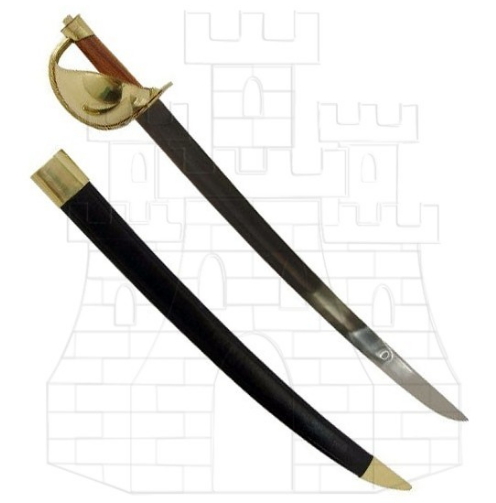 To understand why the cutlass or curved saber worked so well on deck, it is useful to break down its anatomy. A faithful replica is not just aesthetic: its form responds to tactical needs. Below are described the key elements that define an authentic pirate sword.
To understand why the cutlass or curved saber worked so well on deck, it is useful to break down its anatomy. A faithful replica is not just aesthetic: its form responds to tactical needs. Below are described the key elements that define an authentic pirate sword.
-
Blade: generally wide, curved, and single-edged to maximize cutting and balance retention.
-
Thickness and point: the blade is usually robust to withstand blows in close combat; the point may be less sharp than in thrusting swords, prioritizing cutting.
-
Handguard: from closed bell guards to simple guards: they protect the hand and allow hooking and blocking techniques in confined spaces.
-
Hilt: ergonomic, often wrapped in leather or with guards for a secure grip on wet decks.
-
Scabbard: practical, prepared for quick access during boarding actions or maneuvers.
Most representative types
In historical practice and in modern replicas, several models stand out that overlap in design and function: the traditional cutlass, the curved naval saber, and variants with a bell guard or complex guard inspired by military sabers. Below is a comparative table to identify key differences.
| Type | Blade (approx.) | Typical Use | Advantage |
|---|---|---|---|
| Cutlass | 50–80 cm, wide and curved | Naval boarding, cuts in confined spaces | Great cutting power, maneuverability |
| Naval saber | 60–90 cm, pronounced curve | Sailors and naval guard | Speed and control in brief combats |
| Military saber (briquet style) | 60–70 cm, curved but narrower blade | Light infantry and officers | Balance between cutting and agility |
These categories help to identify replicas according to their inspiration: some modern recreations combine elements from various families to create aesthetic or functional pieces intended for LARP practices or stage representation.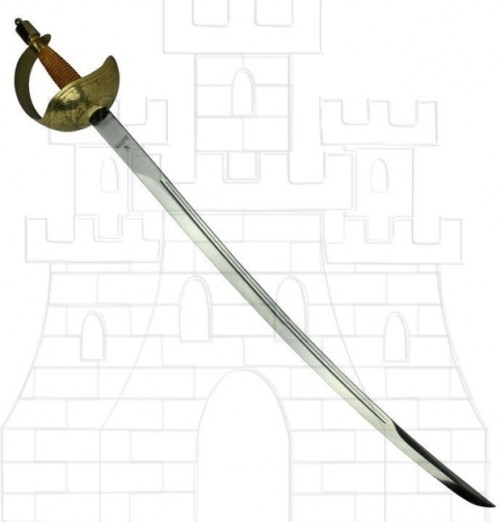
Materials and forging: tradition and modern practice
Today, replicas employ a range of materials according to their purpose: exhibition, scenography, LARP, or cutting practice. The choice of steel and heat treatment defines the durability and performance of the blade.
-
Carbon steels: offer good hardening and edge restoration capabilities, but require maintenance to prevent corrosion.
-
Stainless steels: resistant to oxidation and aesthetic; less suitable for intense blows if not properly treated.
-
Damascus steel: used in high-end replicas for its beauty and combination of hardness and flexibility.
| Material | Advantage | Disadvantage |
|---|---|---|
| Carbon steels | Better hardening and edge | Sensitive to rust, requires maintenance |
| Stainless steels | Low corrosion, easy care | May be less impact resistant if not high quality |
| Damascus | Aesthetic and good balance | High price |
Forging and heat treatment make the difference between a decorative piece and a functional tool. Modern artisans recreate traditional processes, but also apply current techniques to improve consistency and safety.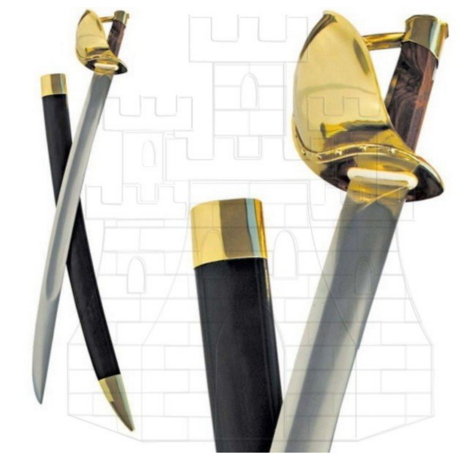
Basic techniques and handling in confined spaces
The essence of combat with pirate swords lies in economical movement: wide cuts, short steps, and utilizing the deck. Techniques you’ll see in historical fencing schools or reenactment clubs often emphasize:
-
Control of the center of gravity: keeping the striking line close to the body to recover after a cut.
-
Horizontal and diagonal cuts: more common than thrusts in boarding situations.
-
Use of the guard: the bell guard not only protects the hand, it also serves to deflect and trap the rival blade.
Clubs that adapt historically informed training incorporate practices of distance, timing, and safety to reproduce techniques without risk, using safe replicas or swords with blunted edges depending on the context.
Replicas and how to choose your pirate sword
Choosing a replica depends on its use: display, reenactment, or practice. Evaluate purpose, materials, weight, and balance. Look for pieces that balance aesthetics, handling, and safety for your activity.
If your interest is in scenography, finish and aesthetic details will take priority. For training, opt for good quality steels and bending and resistance tests. For LARP, the priority is safety and lightness.
Below is a table with practical criteria for selecting a replica according to its use.
| Use | Recommended Material | Key Features |
|---|---|---|
| Display | Stainless steel or Damascus | Detailed finish, decorative scabbard |
| Functional training | Tempered carbon steel | Balance, flex testing, and moderate edge |
| Roleplay / LARP | Lightweight coated materials | Safety, blunt tip, light weight |
One element to consider is maintenance: even stainless steel pieces require periodic cleaning and oiling if used in intensive practice. Care preserves the blade and the aesthetic of the replica.
Brief chronologies: sword routes from the forge to the deck
The evolution of naval bladed weapons is not linear; it is the result of adaptation to new tactics and technologies. From the medieval cutlass to more refined sabers, each piece reflects a need: maneuverability, durability, and a symbol of belonging to the crew or officers.
Technical comparison: cutlass, saber, and briquet
For the enthusiast looking to understand subtleties, this table offers comparative technical attributes:
| Type | Blade Length (approx.) | Profile | Approximate Weight |
|---|---|---|---|
| Cutlass | 50–80 cm | Wide, curved single-edged | 800 g – 1.2 kg |
| Naval saber | 60–90 cm | Pronounced curve, thinner blade | 900 g – 1.4 kg |
| Briquet | 60–70 cm | Moderate curve, compact design | 800 g – 1 kg |
Safe practices and maintenance
If you are going to use replicas in training or LARP, respect safety rules: personal protection, periodic blade inspections, and appropriate training spaces. Never underestimate the energy of a cut: even blunted replicas can cause harm if not handled with prudence.
Basic maintenance includes cleaning, checking for looseness in hilts, and applying products that prevent corrosion. Learning to hold and care for a sword is part of the ritual of historical reenactment and preserves the investment in a quality replica.
Clearing doubts about pirate and medieval swords
What are the main differences between pirate swords and medieval swords?
The main differences between pirate swords and medieval swords lie in their shape, purpose, and design.
- Pirate swords are usually cutlasses or curved-blade swords, designed for cutting and use in fast, fluid combat typical of naval boarding. Their curved blade facilitates wide and quick cuts. They are intended for combat in confined spaces and for quick maneuverability.
- Medieval swords are generally straight, double-edged swords, balanced for cutting and thrusting. Their length is usually between 70 and 100 cm and their weight between 900 g and 1.5 kg. Medieval swords allow for powerful attacks and precise thrusts, being used both on foot and on horseback, with an emphasis on versatility in open close-quarters combat. They feature straight or elaborate handguards to protect the hand and hilts for one or two hands.
Pirate swords prioritize speed and efficient movements in confined spaces, while medieval swords seek a balance between defense and attack, with a focus on durability and the ability to pierce armor.
What materials are currently used to manufacture pirate sword replicas?
To manufacture pirate sword replicas, mainly stainless steels, carbon steel, and Damascus steel are used for the blades, depending on the desired quality and price. Hilts are usually made of wood covered with ray skin, silk, cotton, or plastic materials that imitate these finishes. In more economical models, synthetic materials and modern techniques such as laser engraving and 3D printing are also used for decorative details. These combinations allow for replicas that are visually faithful and durable, integrating both traditional materials and modern manufacturing processes.
How has popular culture influenced interest in pirate swords?
Popular culture has significantly influenced interest in pirate swords by representing these weapons as iconic symbols of adventure, rebellion, and freedom. Pirate swords appear in movies, literature, video games, and themed events, where they are associated with the romantic and brave image of the pirate who seeks treasures and defies authority. This representation has fueled collective fascination and has made swords distinctive accessories within the “pirate” style, contributing to their popularity and the continued interest in pirate themes in general.
What combat techniques are taught with pirate swords in fencing clubs?
In fencing clubs where techniques with pirate swords are taught (similar to longswords or dueling swords that imitate the “pirate” style), basic techniques derived from sport fencing and the handling of one-handed or two-handed swords are usually taught, which include:
- Correct grip of the sword, firm but not tense, to allow speed and precision.
- Basic cuts: overhead cut (strike from top to bottom), underhand cut (from bottom to top), middle cut (horizontal strike), and thrust (straight point forward).
- Strategic movements of attack and defense, with emphasis on timing and precision.
- Defensive techniques based on patience to parry attacks and counterattack.
- Distance and timing work, being careful not to expose oneself while seeking to strike first.
These techniques combine cutting, thrusting, and space control movements with a style that emphasizes both attack and defense, suitable for simulating pirate sword combat safely and effectively in a sporting or recreational environment.
Are there festivals or events where pirate swords are used?
Yes, there are festivals and events where pirate swords are used. A prominent example is the Pirate Fest Las Vegas, an annual festival where activities such as pirate sword battles between captains competing for a title are held, as well as sword handling demonstrations and other presentations related to pirates and Renaissance fantasy. It is also common in Renaissance fairs with a pirate theme to see swordsmen and pirate sword combats as part of the show and atmosphere.
Ultimately, a pirate sword is much more than metal and leather: it is a symbol forged out of necessity, adaptation, and later, collective imagination. Understanding its history, anatomy, and use allows you to appreciate replicas not just as objects, but as tangible narratives of a turbulent era. Now that you know its keys, you can critically evaluate any replica and decide which fits your purpose, combining historical authenticity and practicality.
| Characteristic | Pirate Swords | Medieval Swords |
|---|---|---|
| Blade | Curved | Straight, double-edged |
| Type of combat | Fast cutting, maneuverability in confined spaces | Cutting and thrusting, versatility for open combat |
| Main use | Naval assaults and close-quarters combat on ships | Wars and duels on land |
| Hilt and guard | Less protection, focus on mobility | Protective guard and balanced pommel, for protection and handling |
| Length and weight | Variable, blade generally shorter and lighter than medieval | 70-100 cm, 900 g to 1.5 kg |
